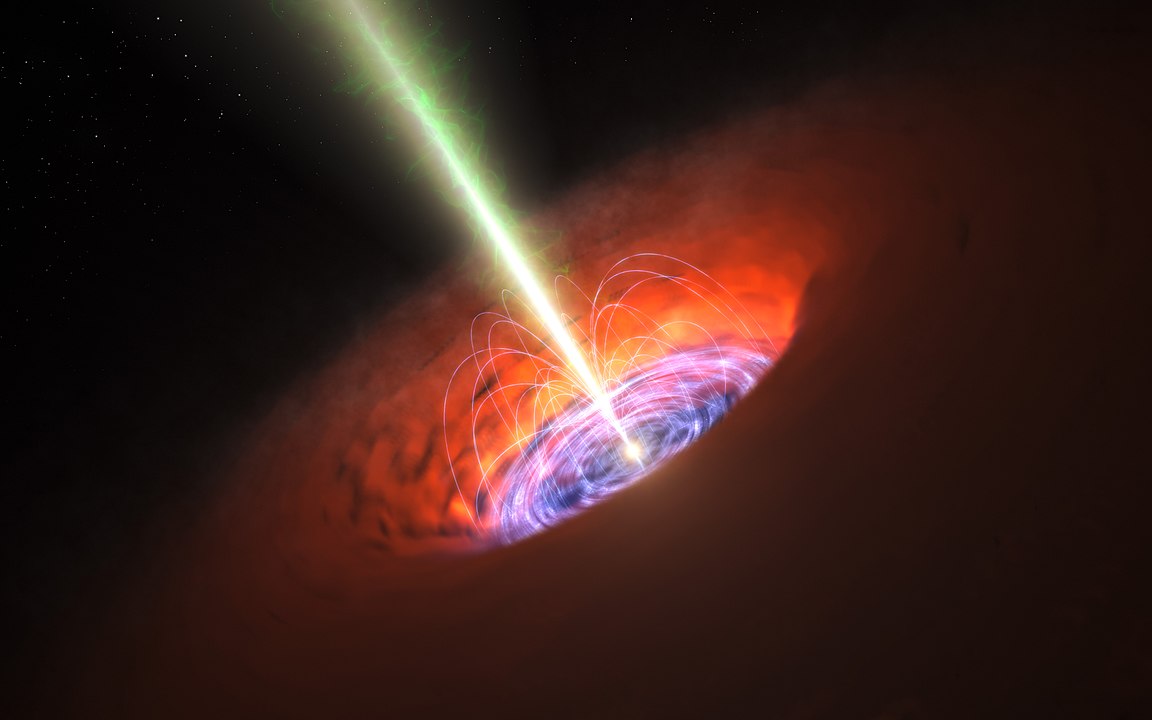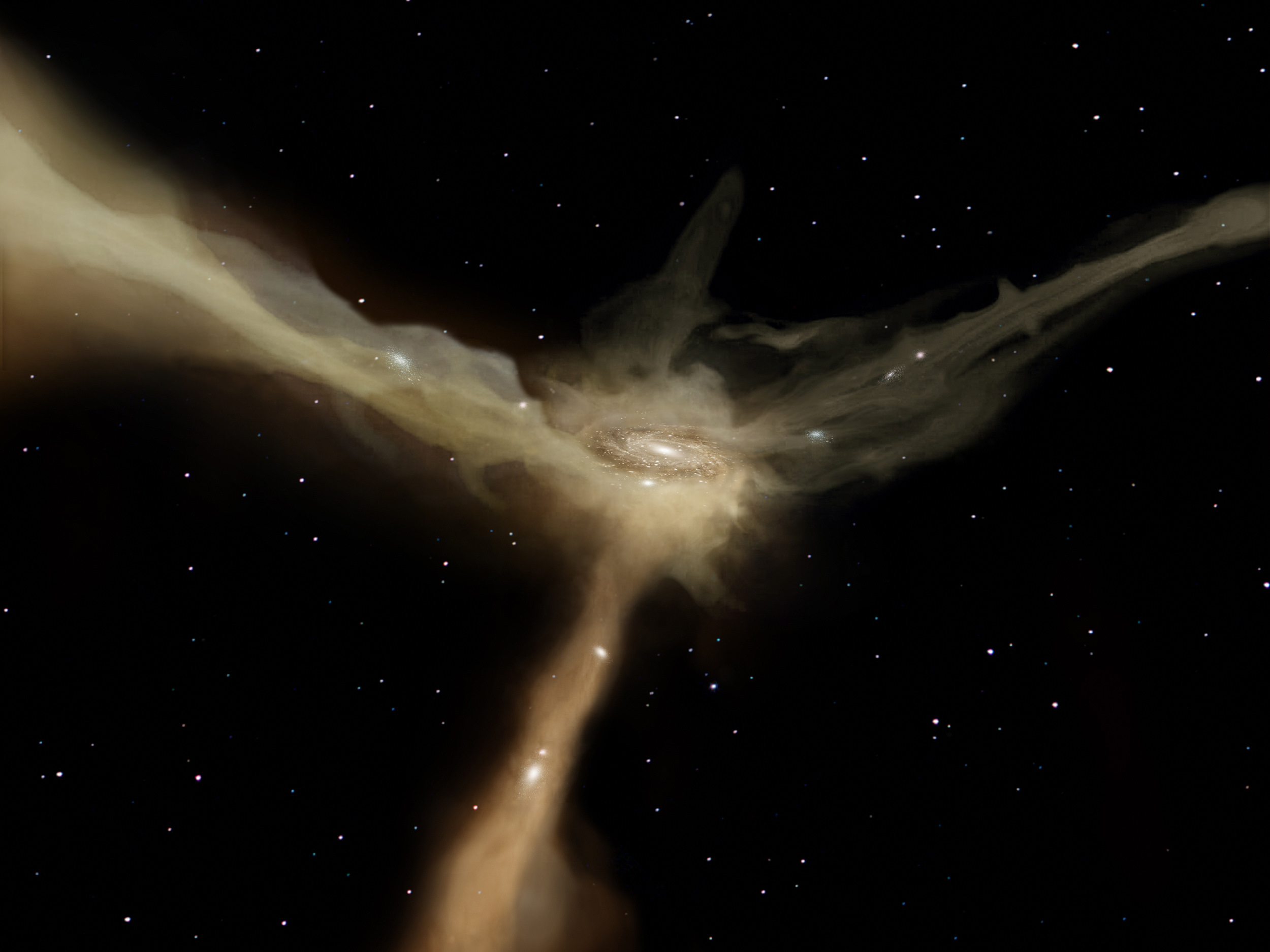Earth and Mars are the only two rocky planets in the solar system to have moons. Based on lunar rock samples and computer simulations, we are fairly certain that our Moon is the result of an early collision between Earth and a Mars-sized protoplanet called Theia. Since we don’t have rock samples from either Martian moon, the origins of Deimos and Phobos are less clear. There are two popular models, but new computer simulations point to a compromise solution.
Continue reading “New Supercomputer Simulation Explains How Mars Got Its Moons”The Early Universe May Have Had Giant Batteries of Dust
The largest magnetic fields in the universe may have found themselves charged up when the first stars began to shine, according to new research.
Continue reading “The Early Universe May Have Had Giant Batteries of Dust”The First Close-Up Picture of Star Outside the Milky Way

Like a performer preparing for their big finale, a distant star is shedding its outer layers and preparing to explode as a supernova.
Astronomers have been observing the huge star, named WOH G64, since its discovery in the 1970s. It’s one of the largest known stars, and also one of the most luminous and massive red supergiants (RSGs). The star is surrounded by an envelope of expelled star-stuff, which could indicate it’s getting ready to explode.
Continue reading “The First Close-Up Picture of Star Outside the Milky Way”Here’s What We Know About Earth’s Temporary Mini-Moon
For a little over a month now, the Earth has been joined by a new ‘mini-moon.’ The object is an asteroid that has been temporarily accompanying Earth on its journey around the Sun. By 25th November it will have departed but before then, astronomers across the world have been turning their telescopes to study it. A new paper of 2024 PT5 reveals its basaltic nature – similar to volcanic rocks on Earth – with a composition that makes it similar to lunar material. There have been many close encounters to Earth allowing many of its secrets to be unveiled.
Continue reading “Here’s What We Know About Earth’s Temporary Mini-Moon”New Study Suggests Black Holes Get their “Hair” from their Mothers

Despite decades of study, black holes are still one of the most puzzling objects in the Universe. As we know from Einstein’s Theory of General Relativity, the gravitational force of these stellar remnants alters the curvature of spacetime around them. This causes gas, dust, and even photons (light) in their vicinity to fall inwards and form disks that slowly accrete onto their faces, never to be seen again. However, astronomers have also noted that they can produce powerful jets that accelerate charged particles to close to the speed of light (aka. relativistic jets).
These jets lead to powerful gamma-ray bursts (GRBs), which have been observed with black holes that have powerful magnetic fields. However, where these magnetic fields come from has remained a mystery to astrophysicists for some time. According to new research led by scientists from the Flatiron Institute, the source of these fields may have finally been revealed. Based on a series of simulations they conducted that modeled the life cycle of stars from birth to collapse, they found that black holes inherit their magnetic fields from the parent stars themselves.
Continue reading “New Study Suggests Black Holes Get their “Hair” from their Mothers”Gaze at New Pictures of the Sun from Solar Orbiter

74 million kilometres is a huge distance from which to observe something. But 74 million km isn’t such a big deal when the object is the Sun.
That’s how far away from the Sun the ESA/NASA Solar Orbiter was when it captured these new images.
Continue reading “Gaze at New Pictures of the Sun from Solar Orbiter”Are Fast Radio Bursts Caused by Interstellar Objects Crashing Into Neutron Stars?

Every now and then, astronomers will detect an odd kind of radio signal. So powerful it can outshine a galaxy, but lasting only milliseconds. They are known as fast radio bursts (FRBs). When they were first discovered a couple of decades ago, we had no idea what might cause them. We weren’t even sure if they were astronomical in origin. FRB’s were so localized and so short-lived, it was difficult to gather data on them. But with wide-field radio telescopes such as CHIME we can now observe FRBs regularly and have a pretty good idea of their source: magnetars.
Continue reading “Are Fast Radio Bursts Caused by Interstellar Objects Crashing Into Neutron Stars?”Here’s How to Weigh Gigantic Filaments of Dark Matter

How do you weigh one of the largest objects in the entire universe? Very carefully, according to new research.
Continue reading “Here’s How to Weigh Gigantic Filaments of Dark Matter”How Could Astronauts Call for Help from the Moon?
Exploring the Moon poses significant risks, with its extreme environment and hazardous terrain presenting numerous challenges. In the event of a major accident, assistance might take days or even weeks to arrive. To address this, Australian researchers have created a distress alert system based upon the COSPAS-SARSAT technology used for Earth-based search and rescue operations. It relies on low-power emergency beacons that astronauts could activate with minimal setup and use a planned lunar satellite network for communication and rescue coordination.
Continue reading “How Could Astronauts Call for Help from the Moon?”There Was a 15 Minute Warning Before Tonga Volcano Exploded
Volcanoes are not restricted to the land, there are many undersea versions. One such undersea volcano known as Hunga Tonga-Hunga Ha’apai off the coast of Tonga. On 15th January 2022, it underwent an eruption which was one of the most powerful in recent memory. A recent paper shows that seismic waves were released 15 minutes before the eruption and before any visible disruption at the surface. The waves had been detected by a seismic station 750km away. This is the first time a precursor signal has been detected.
Continue reading “There Was a 15 Minute Warning Before Tonga Volcano Exploded”




